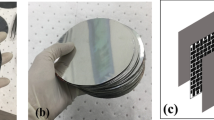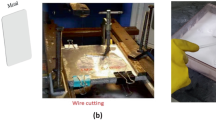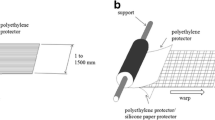Abstract
Lightweight composite materials are being extensively used in the aerospace and marine industry, considering environmental concerns. Fiber metal laminates are one such material that is an answer to the stringent requirement of global ecological concern, along with the capacity to overcome the environmental degradation of monolithic metallic alloys. In this paper, glass laminate aluminum reinforced epoxy (GLARE) in 2/1 configuration consisting of aluminum 2024-T3 with E-glass plain weave fiber prepreg was prepared by hand layup technique in a semi-cured state for carrying out experimental observations. Al skins of different thickness 0.3 mm upper skin and 0.5 mm lower skin were selected considering geometric shape of the required part and forming process for better formability. Hydromechanical deep drawing of the different thickness Al layers in GLARE 2/1 configuration has shown a reduction in overall laminates weight compared to the symmetric GLARE 2/1 laminates having both 0.5 mm upper and lower Al skins, with a considerable depth of the cup-shaped part. The surface treatment, blank holder gap, blank holder force, and die cavity pressure are dominant parameters in fabricating a defect-free part, where predominantly surface treatment contributes to failure due to delamination during forming of GLARE. Other parameters such as blank holder gap, blank holder force and cavity pressure were evaluated using Taguchi L9 orthogonal array method and numerical simulations using Abaqus FEA code which was in close agreement with the experimental observations.












Similar content being viewed by others
Data Availability
All data generated or analyzed during this study are included in this article.
References
Botelho, E.C., et al.: A review on the development and properties of continuous fiber/epoxy/aluminum hybrid composites for aircraft structures. Mater. Res. 9, 247–256 (2006)
Ying, C.: China’s Efforts to Peak Carbon Emissions: Targets and Practice. Chin. J. Urban. Environ. Stud. 9, 2150004 (2021)
Matthews, F.L., Rawlings, R.D.: 6 - Stiffness strength and related topics. In: Matthews, F.L., Rawlings, R.D. (eds.) Composite Materials, pp. 206–222. Woodhead Publishing, Sawston (1999)
Matthews, F.L., Rawlings, R.D.: 13 - Fatigue and environmental effects. In: Matthews, F.L., Rawlings, R.D. (eds.) Composite Materials, pp. 376–391. Woodhead Publishing, Sawston (1999)
Wanhill, R.: GLARE®: A Versatile Fibre Metal Laminate (FML) Concept. In: Prasad, N., Wanhill, R. (eds.) Aerospace Materials and Material Technologies, pp. 291–307. Springer, Singapore (2017)
Alderliesten, R., Benedictus, R.: Fiber/Metal Composite Technology for Future Primary Aircraft Structures. J. Aircr. 45, 1182–1189 (2008)
Evrard, D., Alonso, F.: FAST (Flight Airworthiness Support Technology)–Special Edition A350XWB. Airbus Technical Magazine, US (2013)
Perora, J.: Composite materials in the airbus A380-from history to future. In: 13th International Conference on Composite Materials (ICCM-13). Airbus, Blagnac (2001)
Vogelesang, L.B., Vlot, A.: Development of fibre metal laminates for advance. J. Mater. Process. Technol. 103, 1–5 (2000)
Asundi, A., Choi, A.Y.N.: Fiber metal laminates: An advanced material for future aircraft. J. Mater. Process. Technol. 63(1), 384–394 (1997)
Zafar, R., Lang, L., Zhang, R.: Experimental and numerical evaluation of multilayer sheet forming process parameters for light weight structures using innovative methodology. Int. J. Mater. Form. 9(1), 35–47 (2016)
Parsa, M.H., Yamaguchi, K., Takakura, N.: Redrawing analysis of aluminum–stainless-steel laminated sheet using FEM simulations and experiments. Int. J. Mech. Sci. 43(10), 2331–2347 (2001)
Liu, S., et al.: Investigation into Composites Property Effect on the Forming Limits of Multi-Layer Hybrid Sheets Using Hydroforming Technology. Appl. Compos. Mater. 26(1), 205–217 (2019)
Liu, S., et al.: Investigation into the Fiber Orientation Effect on the Formability of GLARE Materials in the Stamp Forming Process. Appl. Compos. Mater. 25, 1–13 (2018)
Li, L., et al.: Effect of hydroforming process on the formability of fiber metal laminates using semi-cured preparation. Int. J. Adv. Manuf. Technol. 107, 3909–3920 (2020)
Blala, H., et al.: Investigation on the effect of blank holder gap in the hydroforming of cylindrical cups, made of fiber metal laminate. Int. J. Adv. Manuf. Technol. 108(9), 2727–2740 (2020)
Wang, J., et al.: Numerical and Experimental Investigation of a Laminated Aluminum Composite Structure. Appl. Compos. Mater. 26, 1177–1188 (2019)
Lang, L., Danckert, J., Nielsen, K.: Multi-layer sheet hydroforming: Experimental and numerical investigation into the very thin layer in the middle. J. Mater. Process. Technol. 170, 524–535 (2005)
Mennecart, T., Hiegemann, L., Khalifa, N.B.: Analysis of the forming behaviour of in-situ drawn sandwich sheets. Procedia. Eng. 207, 890–895 (2017)
Mennecart, T., et al.: Analysis of the Influence of Fibers on the Formability of Metal Blanks in Manufacturing Processes for Fiber Metal Laminates. J. Manuf. Mater. Process. 3(1), 2 (2019)
Choi, H.S.: Effects of surface pre-treatments and void content on the GLARE laminate process characteristics. J. Mater. Process. Technol. 210, 1008–1016 (2010)
Mubarok, Z., et al.: Effects of Anodizing Parameters in Tartaric-Sulphuric Acid on Coating Thickness and Corrosion Resistance of Al 2024 T3 Alloy. J. Miner. Mater. Charact. Eng. 3, 154–163 (2015)
Sherkatghanad, E., et al.: Innovative approach to mass production of fiber metal laminate sheets. Mater. Manuf. Process. 33(5), 552–563 (2018)
Park, S.Y., Choi, W.J., Choi, H.S.: A comparative study on the properties of GLARE laminates cured by autoclave and autoclave consolidation followed by oven postcuring. Int. J. Adv. Manuf. Technol. 49(5), 605–613 (2010)
ASTM D3039/D3039M-17: Standard test method for tensile properties of polymer matrix composite materials (2017)
Heydari Vini, M., Sedighi, M., Mondali, M.: Investigation of Bonding Behavior of AA1050/AA5083 Bimetallic Laminates by Roll Bonding Technique. Trans. Indian. Inst. Met. 71(9), 2089–2094 (2018)
Zhang, R., et al.: Investigation into thinning and spring back of multilayer metal forming using hydro-mechanical deep drawing (HMDD) for lightweight parts. Int. J. Adv. Manuf. Technol. 82, 1–10 (2015)
Funding
This research work is supported by the National Natural Science Foundation of China [No. 51675029] and the Science and Technology Project of Sichuan province [2019YFSY0034].
Author information
Authors and Affiliations
Corresponding author
Ethics declarations
Competing Interest
The authors declare that they have no known competing financial interests or personal relationships that could have appeared to influence the work reported in this paper.
Additional information
Publisher's Note
Springer Nature remains neutral with regard to jurisdictional claims in published maps and institutional affiliations.
Rights and permissions
About this article
Cite this article
Mirza, H.A., Lang, L., Tabasum, M.N. et al. An Investigation into the Forming of Fiber Metal Laminates with Different Thickness Metal Skins Using Hydromechanical Deep Drawing. Appl Compos Mater 29, 1349–1365 (2022). https://doi.org/10.1007/s10443-022-10024-5
Received:
Accepted:
Published:
Issue Date:
DOI: https://doi.org/10.1007/s10443-022-10024-5




